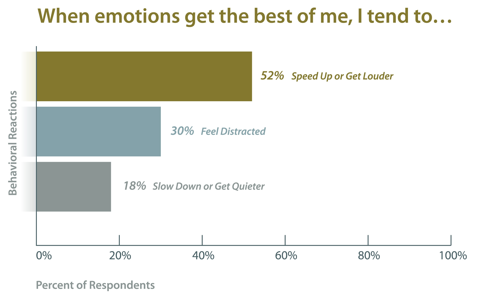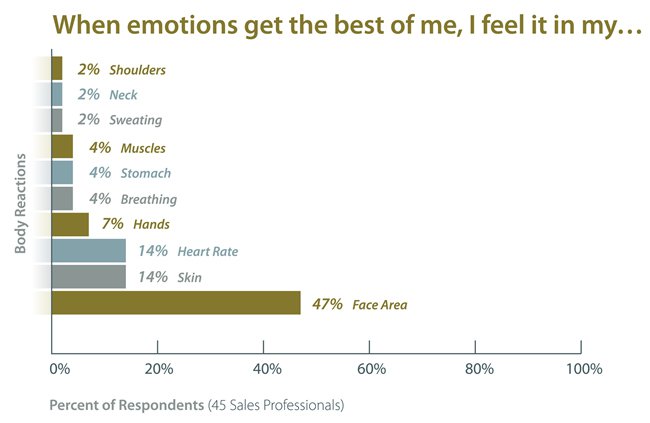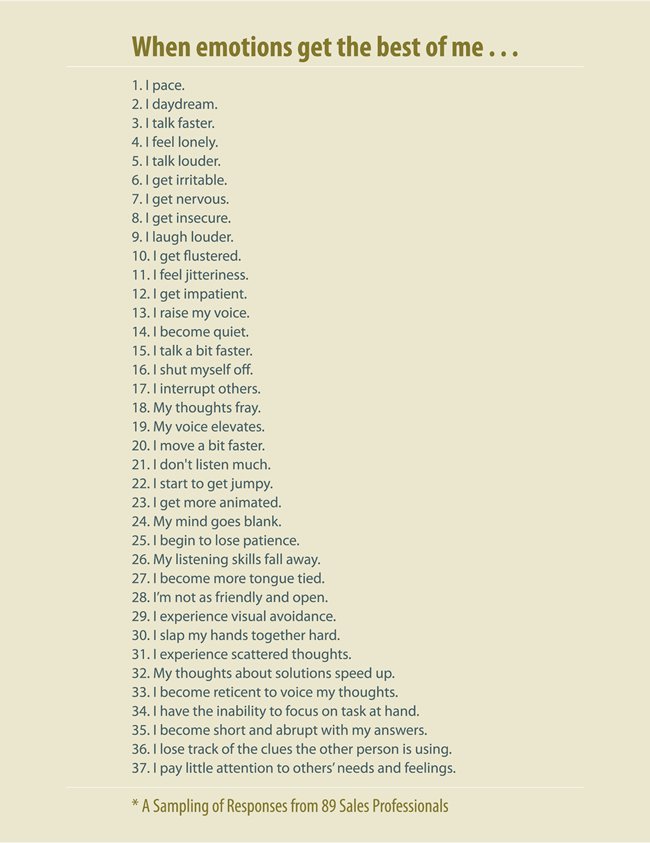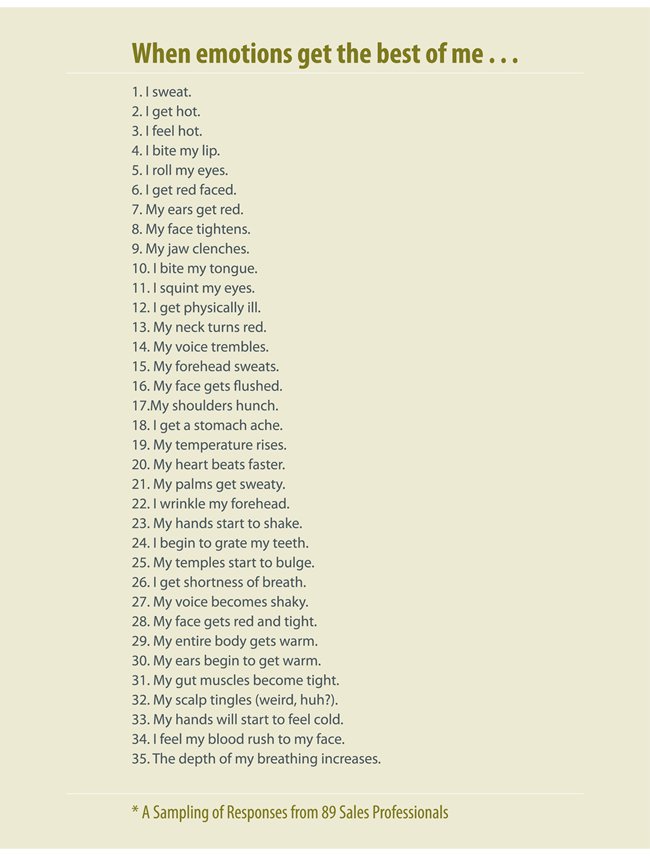
By Dr. Jean Greaves
Five years ago, I was meeting with an executive from a global financial services firm who revealed to me, “I can handle most types of complaint calls, but if the complainer implies that I am the problem, I get defensive and my chest turns red and flashes hot. Fortunately for me, I’m wearing a shirt. No one can see this when it happens.” Since then, I’ve often wondered about the range of reactions people experience when their emotions kick into gear.
This fall, TalentSmartEQ® had the unique opportunity to explore this concern with 89 worldwide sales professionals gathered in Florida for their annual meeting. The following query was posed to them as part of a 13- question pre-work packet on emotional intelligence: What happens to you when your emotions get the best of you? Specific emotions were purposely not mentioned in the packet in order to gather the full range of the participants’ experiences.
The sales professionals’ responses fell into two basic groups—physical reactions to emotions and behavioral reactions to emotions—and most had multiple reactions to a single emotional event. The results reveal something surprising— accurately reading the emotional reactions of other people is far more complicated than we might think.
Up, Down, and All Around
We found that sales professionals behave in one of three ways when their emotions take over: they become louder/ faster (52% of behavioral reactions), slower/quieter (18%), or they become distracted altogether (30%). While one sales professional gets amped by his emotions (“I talk faster”), the next sales person gets shut down by them (“I become tongue-tied”), and the next befuddled by them (“My thoughts fray”). Interpreting how a coworker feels at work may require more than looking for the emotional behaviors and signs that you’re familiar with. Why? Under similar emotional distress, your behavior is likely going to be quite different from that of the person sitting next to you.

Eight Physical Symptoms to Watch For
Next time you’re speaking to someone whom you think might be emotional, remember that the diversity of emotional reactions includes physical symptoms, too. They may feel what you feel, but you might not know it if you don’t know what to look for. When emotions got the best of the sales people we studied, they described physical symptoms in eight different areas of the body. Twenty-one respondents mentioned physical symptoms affecting their head, such as “My face gets flushed.” More specifically, they felt reactions in their mouth (“I bite my tongue” or “I grit my teeth”), their voice (“My voice trembles), their eyes (“I squint my eyes”), their ears (“My ears turn red”), their forehead (“My forehead sweats”), and even their scalp (“My scalp tingles. Weird, huh?”). Other areas of the body affected were the hands, heart, stomach, skin, lungs, and muscles (often in the neck and shoulders).

Social Awareness Skills Require Three Important Strategies
Emotions affect us in many ways, even among one group of employees within one department at one organization. You have to know that one colleague whose hands tremble is just as upset as the person who paces and talks louder. Becoming socially aware requires a sophistication that few bring with them to work. So what can we all do to get better at reading the variety of behavioral and physical cues?
There are three essential strategies for becoming a master at reading reactions. They are 1) paying attention (noticing the symptoms and behaviors that are visible), 2) asking questions (“What are you feeling?”), and 3) remembering what you observe over time (e.g., “the last time I saw my boss pace, she was worried about budgets being cut”). The strategies are not difficult; it’s the diversity of emotional reactions that makes becoming socially aware complex.
We know how important it is to be able to identify and recognize emotional cues from others. It’s critical to understand what’s really going on before charging ahead to judge or act on our assumptions. Since the emotional cues from one person may be very different from the next, the best way to find out how good you are at reading them is to ask the people you work with. Literally go to the source and find out how good a job you are doing of reading their emotions. Once probed, your coworkers will have much to say about your social awareness skills.
The Emotional Intelligence Appraisal® – Multi-Rater Edition is a quick and accurate 360° feedback tool that measures EQ in the #1 benchmark model of EQ. The assessment invites your coworkers to share their perceptions of your EQ in an anonymous and constructive way. The test takes just 10 minutes to complete, and the online results include specific scores for the self-awareness, self-management, social awareness, and relationship management skills. The feedback report includes more than 10 hours of e-learning targeted to your unique score profile.
People use the Appraisal to learn which areas are their strengths, which areas they should work on, and what EQ looks like in action via interactive, Hollywood movie- based e-learning. Users also monitor their progress with our proprietary Goal Tracking System™, which reminds them to work on new skills and share their progress with others.
ABOUT THE AUTHOR:
Jean Greaves, Ph.D.
Dr. Jean Greaves is the co-author of the bestselling Emotional Intelligence 2.0 and the cofounder and CEO of TalentSmartEQ, the world’s leading provider of emotional intelligence tests, emotional intelligence training, and executive coaching. Her bestselling emotional intelligence books have been translated into 25 languages and are available in more than 150 countries. Dr. Greaves leverages her twenty-five year track record of consulting, speaking and applied research. She has written for, or been covered by, Newsweek, Fortune, Forbes, The Wall Street Journal, The Washington Post, and The Harvard Business Review.

